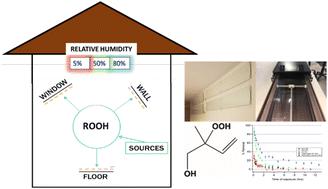当前位置:
X-MOL 学术
›
Environ. Sci.: Processes Impacts
›
论文详情
Our official English website, www.x-mol.net, welcomes your
feedback! (Note: you will need to create a separate account there.)
The fate of organic peroxides indoors: quantifying humidity-dependent uptake on naturally soiled indoor window glass
Environmental Science: Processes & Impacts ( IF 4.3 ) Pub Date : 2023-05-11 , DOI: 10.1039/d3em00041a Marc Webb 1 , Liyong Cui 1 , Glenn Morrison 1 , Karsten Baumann 1, 2 , Jason D Surratt 1, 3 , Zhenfa Zhang 1 , Joanna Atkin 3 , Barbara J Turpin 1
Environmental Science: Processes & Impacts ( IF 4.3 ) Pub Date : 2023-05-11 , DOI: 10.1039/d3em00041a Marc Webb 1 , Liyong Cui 1 , Glenn Morrison 1 , Karsten Baumann 1, 2 , Jason D Surratt 1, 3 , Zhenfa Zhang 1 , Joanna Atkin 3 , Barbara J Turpin 1
Affiliation

|
Humidity plays an important role in the surface removal and concentrations of indoor pollutants such as ozone; however, the indoor surface dynamics and chemistry of organic peroxides is largely unknown. Organic hydroperoxides (ROOHs) are known to participate in the multiphase chemistry of outdoor aerosols and clouds, suggesting that reactive uptake in condensed grime on indoor surfaces is plausible, particularly in humid homes. Here, the effect of relative humidity (RH) on the deposition velocity (vd) and reaction probability (γ) of a model ROOH to naturally soiled indoor glass surfaces was investigated; specifically, by using authentic isoprene hydroxy hydroperoxide (1,2-ISOPOOH) as the model compound. Glass was soiled in 3 local homes for 1+ years and characterized. The removal of ISOPOOH by soiled and clean glass was measured under 5–6%, 56–58%, and 83–84% RH conditions using a novel flow reactor designed for indoor surfaces coupled to an iodide chemical ionization high-resolution time-of-flight mass spectrometer (I-HR-TOF-CIMS). The vd and γ increased with increasing RH, ranging from 0.001–0.059 cm s−1 and 0.4–4.6 (×10−6), respectively, on soiled glass surfaces. The vd and γ ranged from only 0.001–0.016 cm s−1 and 0.1–0.8 (×10−6), respectively, across RH conditions on clean glass, demonstrating a greater RH effect on soiled materials than clean. Loss rates calculated under humid conditions to soiled glass (∼1–6 h−1) were competitive in scale with ventilation rates in typical residences, indicating the importance of surface uptake for indoor ROOH concentrations. This work provides parameters for predictive modeling of indoor ROOHs. To our knowledge, these are the first direct measurements of the vd of an ROOH to naturally soiled indoor surfaces.
中文翻译:

室内有机过氧化物的命运:量化自然污染的室内窗玻璃的湿度依赖性吸收
湿度对于臭氧等室内污染物的表面去除和浓度起着重要作用;然而,有机过氧化物的室内表面动力学和化学性质在很大程度上是未知的。众所周知,有机氢过氧化物 (ROOH) 参与室外气溶胶和云的多相化学反应,这表明室内表面凝结污垢的反应吸收是合理的,尤其是在潮湿的家庭中。这里,相对湿度 (RH) 对沉积速度 ( v d ) 和反应概率 ( γ)对模型 ROOH 对自然污染的室内玻璃表面进行了研究;具体来说,使用正宗的异戊二烯羟基氢过氧化物 (1,2-ISOPOOH) 作为模型化合物。当地 3 个家庭的玻璃被污染超过一年并进行了表征。使用专为室内表面设计的新型流动反应器,并与碘化物化学电离高分辨率时间分析仪相结合,在 5–6%、56–58% 和 83–84% 相对湿度条件下测量了脏玻璃和干净玻璃对 ISOPOOH 的去除情况。 -飞行质谱仪(I-HR-TOF-CIMS)。在脏玻璃表面上,v d 和γ 随着相对湿度的增加而增加,范围分别为0.001-0.059 cm s -1和0.4-4.6 (×10 -6 ) 。v d和γ _在干净玻璃的相对湿度条件下,其变化范围分别为 0.001–0.016 cm s -1和 0.1–0.8 (×10 -6 ),这表明相对于干净玻璃,相对湿度对污染材料的影响更大。在潮湿条件下计算出的污染玻璃损失率(~1-6 h -1)在规模上与典型住宅的通风率相当,表明表面吸收对室内 ROOH 浓度的重要性。这项工作为室内 ROOH 的预测建模提供了参数。据我们所知,这是首次直接测量ROOH 对自然污染的室内表面的v d 。
更新日期:2023-05-11
中文翻译:

室内有机过氧化物的命运:量化自然污染的室内窗玻璃的湿度依赖性吸收
湿度对于臭氧等室内污染物的表面去除和浓度起着重要作用;然而,有机过氧化物的室内表面动力学和化学性质在很大程度上是未知的。众所周知,有机氢过氧化物 (ROOH) 参与室外气溶胶和云的多相化学反应,这表明室内表面凝结污垢的反应吸收是合理的,尤其是在潮湿的家庭中。这里,相对湿度 (RH) 对沉积速度 ( v d ) 和反应概率 ( γ)对模型 ROOH 对自然污染的室内玻璃表面进行了研究;具体来说,使用正宗的异戊二烯羟基氢过氧化物 (1,2-ISOPOOH) 作为模型化合物。当地 3 个家庭的玻璃被污染超过一年并进行了表征。使用专为室内表面设计的新型流动反应器,并与碘化物化学电离高分辨率时间分析仪相结合,在 5–6%、56–58% 和 83–84% 相对湿度条件下测量了脏玻璃和干净玻璃对 ISOPOOH 的去除情况。 -飞行质谱仪(I-HR-TOF-CIMS)。在脏玻璃表面上,v d 和γ 随着相对湿度的增加而增加,范围分别为0.001-0.059 cm s -1和0.4-4.6 (×10 -6 ) 。v d和γ _在干净玻璃的相对湿度条件下,其变化范围分别为 0.001–0.016 cm s -1和 0.1–0.8 (×10 -6 ),这表明相对于干净玻璃,相对湿度对污染材料的影响更大。在潮湿条件下计算出的污染玻璃损失率(~1-6 h -1)在规模上与典型住宅的通风率相当,表明表面吸收对室内 ROOH 浓度的重要性。这项工作为室内 ROOH 的预测建模提供了参数。据我们所知,这是首次直接测量ROOH 对自然污染的室内表面的v d 。











































 京公网安备 11010802027423号
京公网安备 11010802027423号